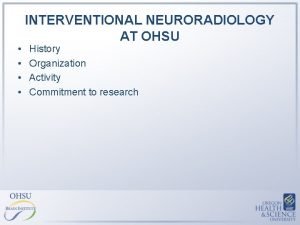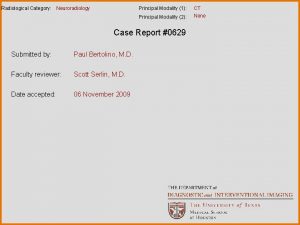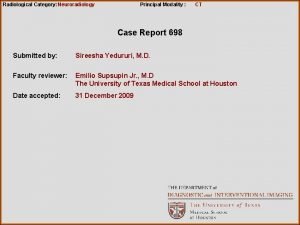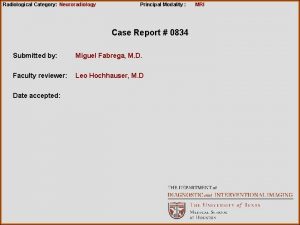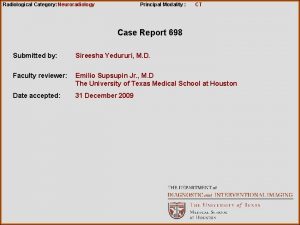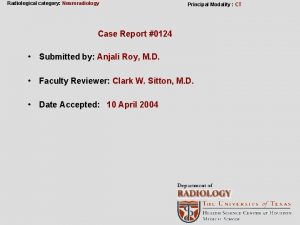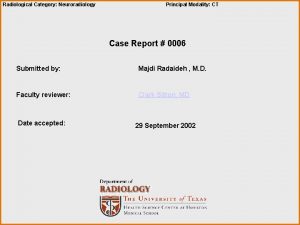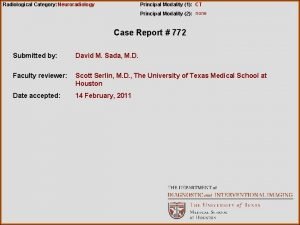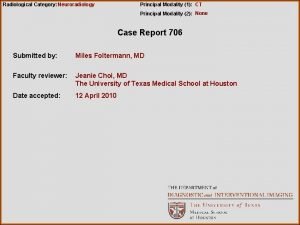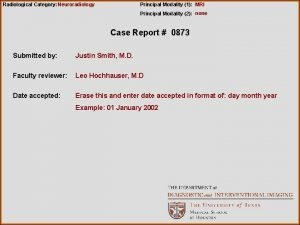Radiological Category Neuroradiology Principal Modality Case Report 0205












- Slides: 12

Radiological Category: Neuroradiology Principal Modality: Case Report #0205 Submitted by: Elliott Friedman, M. D. Faculty reviewer: Clark Sitton, M. D. Date accepted: 14 April 2005 CT

Case History A 1 month old boy was referred for further evaluation after abnormal newborn hearing screening results. Auditory brainstem response testing demonstrated a severe bilateral peripheral hearing loss.

Radiological Presentations Nonenhanced Temporal bone axial CT Scan

Radiological Presentations

Radiological Presentations

Radiological Presentations

Radiological Presentations

Test Your Diagnosis Which one of the following is your choice for the appropriate diagnosis? After your selection, go to next page. • Bilateral cholesteatomas • Cochlear otospongiosis • Post-meningitis labyrinth ossification • Mondini deformity • Ossicle hypoplasia

Findings and Differentials Findings: The CT scan of the temporal bones demonstrates bilateral apparent symmetrical abnormality involving both bony labyrinths. It is inferred that the membranous labyrinths are also involved. The right cochlea contains approximately 1. 5 turns, and the left cochlea is absent. The vestibules are enlarged and fused with hypoplastic semicircular canals. The vestibular aqueducts are prominent. Ossicles are present bilaterally, however no oval window is present on the left. Differentials: • Mondini spectrum • Michel’s deformity/ Complete labyrinthine aplasia • Common cavity • Cochlear aplasia • Cochlear hypoplasia

Discussion The otic capsule structures typically form between weeks 4 -10 of gestation. The Mondini spectrum is the most common congenital cochlear defect, probably due to an arrest in maturation during the seventh week of gestation. Usual findings with Mondini deformity include incomplete cochlear development. There is incomplete partition of the cochlea. Often the basal turn is fairly well formed, but a common cavity is present where the medial and apical turns should be. A cystic inner ear structure may be found in the normal location of the cochlea. Other anomalies of the inner ear may also be present. 20% of affected individuals demonstrate an enlarged vestibule secondary to enlargement of the endolymphatic sac. The enlarged vestibule may contain abnormal or missing semicircular canals and incompletely developed sensorineural structures. Complete labyrinthine aplasia (Michel’s deformity) is aplasia of the inner ear. No inner ear structures develop and a small single cyst or multiple cystic structures are present instead. This developmental arrest occurs during the third week of gestation.

Discussion Arrest in development during the fourth week of gestation results in a common cavity for the cochlea and vestibule. No internal architecture is present within the large cystic cavity. The semicircular canals may be normal or malformed. Unlike complete labyrinthine aplasia, an internal auditory canal is present. In cochlea aplasia, no cochlea forms, and in cochlear hypoplasia a small rudimentary cochlea forms. These anomalies result from arrests in development at the fifth and sixth weeks of gestation respectively. The vestibule and semicircular canals may be normal or malformed. References: Som P, Curtin H. Head and Neck Imaging. St. Louis, MO: Mosby-Year Book, 1996; 1361 -1377.

Diagnosis Mondini spectrum deformity.
 Ohsu neuroradiology
Ohsu neuroradiology Erate pa
Erate pa Center for devices and radiological health
Center for devices and radiological health National radiological emergency preparedness conference
National radiological emergency preparedness conference Radiological dispersal device
Radiological dispersal device Tennessee division of radiological health
Tennessee division of radiological health Best worst and average case
Best worst and average case Apollo planogram software
Apollo planogram software Modality
Modality Epistemic modality
Epistemic modality Deontic and epistemic modality exercises
Deontic and epistemic modality exercises Pacs modality workstation
Pacs modality workstation Cardinality and modality
Cardinality and modality
